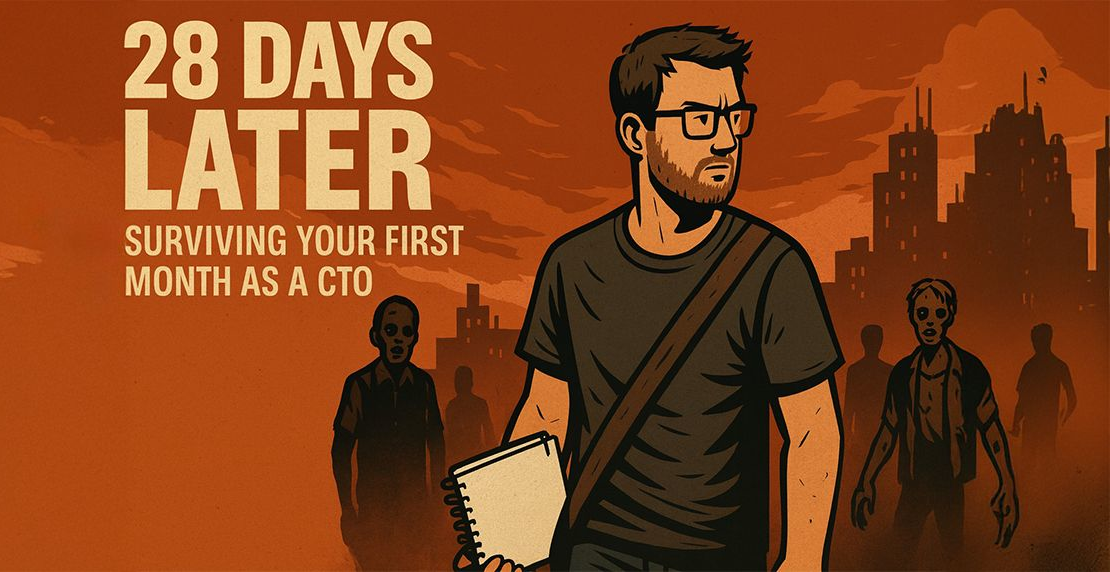There’s a tired old trope in leadership circles: “Your first 100 days define your legacy.”
Cute idea. Presidential even. But let’s be real: in a tech org, 100 days is a lifetime. By the time you’re on Day 101,
you’re not building credibility – you’re shambling through the hallways, moaning about roadmaps, and scaring
interns. In other words: You’re already a Zombie CTO.
You don’t get 100 days. You get 28. Roughly three sprints if you’re on a 10-day cycle, and that’s all the slack you’ll
ever get. If you don’t establish trust, show judgment, and land a couple of quick hits by then, you’re at best
irrelevant – at worst, undead.
So here’s your 28-day survival guide – not theory, not TED-talk fluff, but field-tested tactics for how to stay
alive (and keep your org alive with you).
Week 1: Recon (Observe and Listen)
Every good survival movie starts with a stunned hero waking up and realizing the world’s on fire. That’s you. Don’t
sprint off with a machete yet – you’ll lose a limb before you find the snacks.
Find out who, how and what you work with:
- Meet the other survivors
Block time with the CEO, Head of Product, and engineering leads. Ask about goals, pain
points, and what’s keeping them up at night. Listen twice as much as you talk.
- Join the rituals
Sit in on standups, planning sessions, and retros. Don’t hijack them – you’re a guest in
their camp.
- Scan the terrain
Review the backlog, peek at architecture docs, dig through incidents. Don’t panic when you
find the duct tape holding things together.
You earn trust by paying attention. If you come in guns blazing with a new process on Day 3, you look reckless, not
decisive.
Week 2: Spot the Threats
By now, you’ve seen the shamblers in the distance. Time to figure out which ones can actually bite.
Identify the real risks:
- Bottlenecks
Is deploy frequency glacial? Do product decisions wait on one person? These choke points will kill
velocity faster than any zombie horde.
- Fragile systems
Which services are “held together with duct tape and prayer”? Draw the blast radius if they go
down.
- Broken processes
Is CI a daily roulette? Are pull requests stuck in limbo? Look for the systemic rot, not just
the loudest complaints.
- Map it
Build a lightweight “system map” – org structure, architecture dependencies, team
responsibilities. This isn’t an art piece for Notion; it’s your field notes on how the outbreak spreads.
Don’t write a novel. A one-page diagram beats a 40-slide deck when you’re pointing at smoke on the horizon.
Week 3: First Strikes
The survivors are nervous. They’ve heard you’re in charge, but so far you’ve just been scribbling in a notebook. Time to
pick up the axe.
Land 1–2 quick, visible wins:
- Kill a useless meeting
Nothing signals leadership like giving people back time.
- Fix a daily annoyance
In three different companies, I’ve rolled out a proper status page. Every time, the org
cheered like I’d invented sliced bread. Don’t underestimate the power of fixing something small but painful.
- Unblock CI/CD
If the team is wasting hours on flaky tests or broken pipelines, fix it. You’ll look like a
wizard.
- Improve dev experience
A tiny tooling upgrade (faster local builds, a Slack integration) can generate more
goodwill than a six-month strategy doc.
These are symbolic strikes: actions that prove you’re decisive, but not disruptive. Slide-deck CTOs are zombies
already – if all you do is make slides, the team will write your obituary before your first quarter ends.
Do something. Don’t overthink it. A small, concrete fix beats a visionary speech every time.
Week 4: Establish the Safe Zone
Congrats, you’ve survived three weeks without becoming lunch. Now it’s time to set up something sustainable.
Define your leadership style:
- Share your findings
Present your system map and top risks to leadership and team leads. Keep it clear and
brutally honest.
- Define the next priorities.
Pick the top three to tackle in the next quarter. Make them visible, measurable,
and aligned with company goals.
- Signal your values.
Be transparent. Focus on outcomes, not vanity metrics. Show collaboration by looping in
product and ops.
And a few ground rules for survival in the camp:
- Don’t wear a suit
You’re in a war zone, not a boardroom. Polo and jeans, maybe a t-shirt and shorts – you
need to move fast, not look like an extra from Suits.
- Never flex your title
Everyone already knows you’re the CTO. Announcing it just paints a target on your back.
If you must say something, try: “I’m responsible for engineering and tech.” Way less pompous, way more credible.
- Pick your battles
Don’t waste energy arguing with burnt-out survivors who’ve mentally checked out. Save your
strength for working with the people who still want to fight.
- Don’t be an asshole
Sounds obvious, but you’d be surprised. Respect goes further than bravado. In an
apocalypse, nobody follows the jerk with the loudest voice.
- Don’t try to be the smartest in the room
You don’t need to out-code or out-architect everyone. Your job is to
spot the smartest people, listen to them, and amplify their impact. That’s how you win.
The camp doesn’t need a hero; it needs a leader.
Week 5 (If You’re Still Alive)
If you’ve made it this far, congrats – you’re not a zombie, you’re the leader of a scrappy band of survivors. Now
the game shifts: you’re not just surviving; you’re planning for a future.
Here’s how to keep civilization alive:
- Arm the people
Don’t let your team fight the apocalypse on outdated gear. A maxed-out MacBook
costs $5k. A new hire costs $50k+. Do the math. Equip your people.
- Invest in morale
Happy survivors fight harder. Hire someone to own employee satisfaction, run lightweight
engagement surveys, or at least fix the coffee machine. It matters.
- Research a vaccine
You can wall off problems for a while – weak leadership structures, missing feedback
cycles, no career paths. But long-term survival means tackling org development. That’s your R&D for the future.
- Expand the perimeter
Once you’ve got a safe zone, look outward: improve cross-team collaboration, start
aligning engineering with product strategy, and build the case for scaling.
- Secure supply lines
Make sure hiring pipelines, onboarding flows, and vendor contracts don’t become
bottlenecks. Nothing’s worse than running out of people, tools, or budget mid-crisis. Survivors without supplies don’t
stay survivors for long.
- Take out the infected
Sometimes you need to remove toxic players to protect the group. It’s never fun, but
letting one infected survivor roam free is worse.
- Build new captains
You can’t fight every battle yourself. Invest in team leads and emerging leaders –
train them, empower them, and give them room to make decisions. Strong captains keep the camp running when you’re off
scouting the horizon.
Survival is urgent, but civilization is strategic. The best CTOs balance both – today’s fires and tomorrow’s
foundations.
The Hard Truth
You don’t have 100 days. You don’t even have 50. You have 28. If you spend your first quarter “assessing” while the org
stumbles, you’ll wake up to find someone else making decisions for you – and the team treating you like background
noise.
Move fast. Build trust. Land early wins. And carve out a safe zone for your team before the chaos swallows you.
So ask yourself:
Are you leading in your first month – or shambling around as a Zombie CTO?



